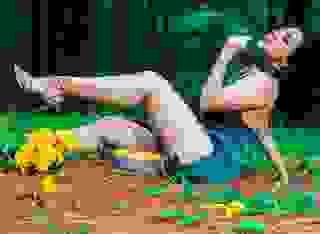Note: You can change font size, font face, and turn on dark mode by clicking the "A" icon tab in the Story Info Box.
You can temporarily switch back to a Classic Literotica® experience during our ongoing public Beta testing. Please consider leaving feedback on issues you experience or suggest improvements.
Click hereTheir local handicrafts are most charming, and before my return to Ukraine, I shall pick up some for your lovely family. I have heard it said that the few remnants of the American peoples are finally becoming less rebellious, unlike some of our new Comrades in Progress, such as the peoples of the Western European countries. Most astounding that the people of France, long considered dilettantes (to use their word), should be the most resistant, with fighting there now in its 9th year....
Our train ride was most comfortable, the train cars quite plush and much nicer indeed than any to be found at home. It is a pity that their manufacture was the product of capitalist slave labor, and that they are no longer being produced. Strange that slaves should do such fine work! I am told that the oppressed of America are relieved to be freed of the burden of self-determination, but I can't help but wonder how that might be. Is such a thing logical?
As our cars passed through the ruins of other, smaller American villages, the sights were similar - the proud American rabble congregating around their symbols of bankrupt religion, though if it gives them solace, I suppose it is a good thing. As Marx said, "Religion is the opiate of the masses."
But what is to serve as my opiate?
* * * *
From: n.omelchenko@jdf.mil
To: polova_kvitka @zmail.com
Sent: 06/12/2051 21:27:12 Zulu
Subject: We have arrived!
My Dear Anya:
It is a beautiful country, this Montana state, with its profusion of daisies in bloom, seemingly everywhere. I am told that this section of America is very quiet, with no native Americans seen for days at a time, when one is traveling from site to site. I am not sure if that is due to the rural nature of this part of America, or if their conflict with their king destroyed much of the population in this part of their country. There is no doubt, however, that we will not see any Americans within the Onion Creek Crossing district, for reasons that I will later tell you, though you may have heard the rumors.
Our encampment has been in place now for one week. Of course, we are not located within the Onion Creek Crossing district itself - that would be foolish, and nearly impossible. We have located 20 kilometers away, outside of the contamination zone, and travel to the site early each morning in army trucks, which must be thoroughly disinfected every time they leave the zone. That is, American army trucks, as they are more reliable than our own. The contradictions of superior quality capitalist slave labor products, again, versus those produced by our free Democratic Federation.
The greatest danger in Onion Creek Crossing today, are strange micro-organisms, apparently produced by the Americans in the civil war getting past the 16 km perimeter surrounding it, and infecting the population. Apparently there were no vaccines then for the weapons used, nor are there yet today, as I understand it.
It considered a zone of immediate death, this Onion Creek Crossing area.
I am told that there was a truly heroic battle there, with tens of thousands of American military fighters attacking their own people as the people fought in a 'glorious' revolution against their King.
The food we are given, sadly, is of poor quality. None of it fresh, naturally, as growing chickens, vegetables or, livestock are out of the question. I had hoped to be able to enjoy the rare treat of beef during my trip to North America, but it is not to be, I suppose. The canned rations are edible, if only barely, and only 1 out of 10 or so are found to be spoiled when opened, so we count ourselves fortunate.
I should describe the Onion Creek Crossing district to you, so you may envision it, but as you know, I am no author of any merit! You have heard the rumors, of course, but none of these convey the feel, sights, smells and other tactile imagery to you, as I will try, in my cheap and clumsy way.
Our camp was set up in the conventional way, on the high ground above the crossing, to better establish a perimeter and defenses (though no need for defense has yet made itself apparent), and of course to prevent the possibility of flash floods, a reflex we of the Federation Army must take with us everywhere. Few among us here have forgotten the disaster of Laughlin, in the Nevada State, when the Dam of Hoover on the River of Colorado was destroyed for military reasons, and the tragedy that resulted downstream all the way to the Pacific Ocean. We have set a platoon of soldiers around the camp perimeter, as well as concertina wire, so we can certainly feel secure.
I have met with my assistants to divide up and assign their tasks. They are dedicated, and truly professional, and I know that they will do their best to complete our assignment. We are a party of ten scientists, with an accompanying two platoons of infantry soldiers and support personnel. The soldiers are sometimes coarse, but I suppose that is in the nature of a common soldier in the JDF.
There are several American native peoples assigned to our party, with knowledge of the geography and the ways of the region. They are nearly always silent unless addressed, and smile quickly when our eyes are on them, but sullen otherwise.
I have initiated several conversations with one, a young girl, perhaps eighteen or nineteen, named Cheyla. She is tall, nearly 5' 8" in height, and slim, nearly thin. Her hair is a brilliant gold, evocative of the sun, long, and tied back in what I believe they call a "pony's tail." Her blue eyes show great intelligence, and none of the sullenness so commonly found in others of her heritage. I find her looking at me thoughtfully at times, and it unnerves me a little, but it interests me also. She converses readily, and speaks forthrightly when she needs to.
* * * *
From: n.omelchenko@jdf.mil
To: polova_kvitka @zmail.com
Sent: 06/18/2051 12:01:16 Zulu
Subject: Sadly, much death here
My Dear Anya:
I believe I owe you a description of our findings. So, allow me to describe the area to you. Please forgive me if I become pedantic.
The site of Onion Creek Crossing is an area of approximately 120 hectares or about 7700 square meters, in a roughly triangular shape, with two sides of the triangle bounded by an abandoned roadway called "U.S. 90" on the western side extending 2000 meters from its junction with another decaying and unused roadway called U.S. Highway 212 on the north-eastern side, also extending 2000 meters, and in the southeast section of that rough triangle.
Located in the south-central portion of the State of Montana, the area is geologically uniform. The upper 2/3 of the Crossing is a moderate slope composed of arid grasslands. The zoology of this portion is primarily absent - above the level of annelidae, there are no animals of any sort.
The lower 1/3 of the Crossing, that running along the river, is primarily forested flood plain, with uniform soils and geomorphology, and a small creek called "Onion" running through it. Oddly, the native workers persist in calling the upper area "Little Big Horn," though I can find no references to such a site in our preliminary documents. I must ask Cheyla about this discrepancy. I trust her, and look forward to her conversations. There are many white stone blocks scattered through the upper grassy meadow, much like gravestones and marked similarly. There are references to a "Battle of the Little Big Horn" here centuries before.
More importantly, there are plentiful signs of a modern battle here, of the worst kind.
There are indications of a circle of perhaps hundreds of military vehicles and at least a hundred times as many men, having been arranged around the center of the most biologically contaminated area, and standing off it by perhaps a kilometer, as though completely surrounding a smaller group. I am having trouble reconciling this arrangement with the forces we have been told were present at this decisive battle. I assume that these thousands of troops must have been the forces of the King of America.
But our greatest interest is in that center portion, between the massed offensive forces (?) of American military. It is only there that we find vehicles of all sorts, and remnants of corpses. It is an awful sight. While a few corpses are dressed in the rags of military uniforms, many others are not - they are clothed in civilian garb of that era. Many still bear shoes, or in the case of upper extremities, watches, necklaces and other such adornments, but none wearing military identification, what Americans call "dog tags." There are smaller remnants which I fear may represent children. It is a sickening sight, one for which I admit I was not prepared. Although I serve in the Defense Force, I am not a military woman, as you know, and the proximity of such tragic death reminds me ceaselessly of the two deaths so close to me.
Our investigations continue.
A remote spot on the banks of the Onion Creek a few kilometers south, makes an ideal spot for me to gather my thoughts. 'Borrowing' an American Humvee from the soldiers, I skirt the perimeter of the district, so that I need not wear the bio-hazard suit that is our only permitted garb inside the Onion Creek Crossing district.
With no road to drive on, I must traverse a rough track to the water's edge, reaching the sparkling, rapidly running flow in only a short time. The water is clear, as though looking through a sheet of rough glass, and one can see the Yellowstone cutthroat trout fish3darting to and fro beneath it. They bring to me a peacefulness that I cannot find elsewhere in this sad land, and so I continue to visit the small river on a daily basis.
Along its rapids is a long stretch of sand and large cobbles, on the inside bend of a horseshoe turn in the river. At a point about halfway down the 100 meter stretch of sand and stones, a large tree overhangs the water, and several flood-strewn logs form a comfortable seating area. Behind the large logs, tucked between the flowing river, and the river bank up slope, are several still ponds, no more than 8 meters in length, and 6 meters wide, approximately a meter deep, with small schools of minnows in each. I ponder their fate, as the ponds are land locked, and their water levels renewed only when it rains or the river floods. I suppose they must die then, when the life-giving water doesn't come, and face their mortality, as we all must.
Earlier today, the young American girl Cheyla asked me why we were visiting the Onion Creek Crossing site, or as she called it, "Little Big Horn.". I asked her where that name came from, and she told me of an ancient American soldier who had come to misfortune there centuries before, a General Custer and his troops, against the native Americans. Obviously an earlier revolt by the people against perhaps an earlier American king.
I responded that we are here to make observations, take measurements and propose theories. She looked at me as though she were looking through me, but said nothing.
It is possible that she is feeling the weight of the death that this area holds. I must keep an eye on her, though I believe she will serve us as ordered. There is something about her, though, that disturbs me, but also pleases me, and I trust her actions.
****
From: n.omelchenko@jdf.mil
To: polova_kvitka @zmail.com
Sent: 06/27/2051 15:35:37 Zulu
Subject: Disturbing thoughts
My Dear Anya, we have completed our assessment of the plant life and zoology in the area of the Onion Creek Crossing district.
It is most disquieting. Early settlers found the area to have an abundant prairie dog population, as well as serving as a seasonal feeding area for bison. Although civilization only lightly impinged on the area over the years, the bison population disappeared, as it did across the American Plains, and the prairie dog population at first exploded, but later declined to a stable level as coyotes moved into the area. The zoology of the area was, of course, heavily impacted by man's activities, as described above, with cattle being omnipresent over the last 200 years, since the 1850's.
After the events of two decades ago, the mammalian and vertebrate population of Onion Creek Crossing rapidly declined to an estimated zero, most likely due to the lingering effects of the microbiological agents used against the combatants and civilians alike gathered there. The insect population was also cut down severely, but soil-dwelling creatures such as annelid worms managed to survive. This lack of animal scavengers helps to explain the recognizable condition of many of the casualties even twenty years later. I am told that we may find the corpse of the King of America, which would certainly be a great political coup. Many of the approximately 700 corpses, all American, on the site are all still quite identifiable as human, though dried, weathered and mummified to a great extent.
The vehicles of the 700 are still distinguishable, scattered throughout the battle zone, a fleet of mainly Hummers and black vehicles called "Sport Utility Vehicles," popularly used and reserved to American government officials in those days, but also many common vehicles that look much like the vehicles back home, but these are rusted and derelict. There is an odd absence of purely military vehicles - a battle with no military vehicles, no tanks, no armored trucks or troop carriers? Our technicians have determined that their only significant malfunction of many vehicles appears to be an absence of fuel, though that may just be the effect of the passage of time and evaporation.
I have previously described this area that we are surveying, primarily grasslands almost too dry to support even the fabled buffaloes of this land. But one anomaly has been noted by our staff: the areas in which casualties from the battle we find ourselves studying, were massed, and of course unrecovered due to contamination by microorganisms, have showed the greatest amount of advanced plant growth, with deciduous growth of one kind or other.
In one area, thought to hold the remains of approximately 130 corpses, there is an oak tree 10 meters tall, remarkable as it is the only oak tree for at least 80 km.
I find myself disquieted at the thought of these people, once living, now serving merely as a source of nutrients for plant life in the district. Can this be the summit of our achievement? If so, I am troubled. The girl Cheyla has grown even quieter than before, if that is possible, but I insist that she be with my party whenever I go out. She may be helpful to my own understanding of the violence that occurred here. She seems bemused by the isolation suits that we wear, but I insist that she wear it too. I would regret immensely if she were to come to harm. She fascinates me in the way that she walks, and the way that she looks at me, and even in her shy, too infrequent smiles.
I have retreated to my haven of quietude by the river's edge, to contemplate the meaning of all that we are seeing and finding. As everyone in the JDF knows, or at least as we were told and believed, the final battle of the American War for Independence was fought here. As the American Monarch celebrated his Battle of Yorktown to free his kingdom from the British monarch, and as others celebrated the Battle of Berlin to bring the second of the three World Wars to a close, we in the JDF have acknowledged the Battle of Onion Creek Crossing as a great triumph for the native Americans, little knowing the full particulars.
I am finding difficulty in reconciling the death here, with the glory assigned to our soldiers. I am proud, yes, that we won, but at what price? We have discovered that the dead here are all Americans. Numbering perhaps 700 or so, I fail to understand such relatively small numbers, when we are told an army of thousands of Americans were defeated. Were the rest somehow removed, and these are only the unrecovered? And why are so many of the Americans only dressed in civilian garb? And why are there corpses of children present? Yes, they are children!
And if it is the Americans that we find slaughtered, where was the 'small JDF force' that we are taught assisted the rebel forces to overcame them located?
The American dead were not even buried. What must their spirits think of us for our iniquity? Nor have we found any weapons of any significance among the American dead, though they should be present after only a few decades have passed. A few handguns, but nothing else. What sort of warriors lack the tools of their trade? Who would initiate a battle with handguns? They must have been insane, if history as we currently know it is to be believed.
Perhaps I am tainted by the seeds of the religion my parents tried to instill in me starting some 44 years ago. I thought it had washed off me, but, I think more and more of what a Divine Being must think of us, the victors.
Cheyla has noted my nightly visits to this site of reflection, and has asked to accompany me tomorrow. Perhaps I will allow her to come along. I have observed that she is a very thoughtful and serious person. I think that I am beginning to admire her very much and perhaps something more.
****
From: n.omelchenko@jdf.mil
To: polova_kvitka @gmail.com
Sent: 7/4/2051 2:27:43 PM Zulu
Subject: An unexpected holiday and love
My Dearest Anya,
Cheyla accompanied me to my haven by the river nearly three weeks ago, and nightly ever since. I wish I could share with you what transpired there, but I do not believe this message would get through to you. Do you remember the two girls, Bohdana and Oxana, from upper secondary school? Do you remember their "special relationship?" Well, that is the image you may keep in mind of Cheyla and I. When I am back in Kyiv I will bring her to you, and you will hear all of our story! I haven't been so happy since, well, you know when my melancholy began.
Chapter 6
Nadya seated herself on the mossy surface of a log, inches from the water running rapidly on one side, and the still pool on the other. She looked at Cheyla.
"You are such an enigma," she said to the American girl. Cheyla smiled.
"I'm not really as mysterious as you make me out to be," she said to the Ukrainian woman, "I just don't speak unless I have something to say."
"Most women are chattering crows," Nadya said, then smiled in return. "You are not, but I find myself wishing you would speak more. Your voice is light, and musical."
"I'm afraid that I'm a musical tune without any lyrics," Cheyla said.
"What do you think happened here, Cheyla?" Nadya asked. Cheyla stared at her.
"You don't really want to know," Cheyla said, sotto voce. Nadya's forehead wrinkled in confusion.
"Of course I do!" she expostulated. "I am a researcher. I determine facts, based on what I observe, and on what I hear, if there is truth to it."
"You're looking for truth?" Cheyla said, wryly. "There's no truth here. Only death."
"Yes, but how did it occur?" Nadya said. "We have our version, and I want to make sure it is the truth."
"Well, that's where you're likely to go wrong," Cheyla said. "Your version is all wrong."
"Our version says that the King of America fought his final battle against your people's Revolution for Independence here, and that your people won a great victory. This will become the American people's most famous and revered site, no?"








